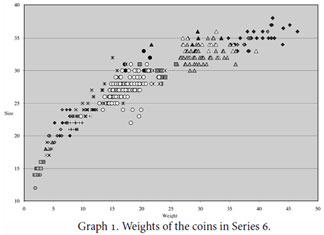The Chronology of Second Century Ptolemaic Bronze Coins:
Two Different Methods to Graphically Interpret Weight/Size Data
Graphing of weight data versus Svoronos numbers gives an illustration of the chronology of 2nd century bronze coinage
In order to produce a valid graph (such as that to the right) the data involved must be numeric (i.e., composed solely of integers). Illustrated in F&L Graph 1, there is an algorithmic relationship of weight (in grams) and diameter (in millimeters). These two numeric characteristics, grams versus millimeters, are two aspects of the coins that gave rise to F&L's very informative and useful Graph 1. In addition, however, there is a third aspect of the coins that can be made numeric and this has the potential to give chronological information in metrological graphic form. |
|
It is the types (i.e., obverses/reverses) of the coins that are the third aspect of the extensive data available in F&L's Table of Hoards. Click RP-Chronology to see the development of a chronological graph from the data in |
Click here to see a larger image of this weight vs size graph |
||
